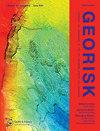黄土滑坡的体积膨胀效应及影响因素分析——以中国黄土高原黑方台塬为例
IF 4.8
3区 工程技术
Q1 ENGINEERING, GEOLOGICAL
Georisk-Assessment and Management of Risk for Engineered Systems and Geohazards
Pub Date : 2023-09-18
DOI:10.1080/17499518.2023.2257201
引用次数: 0
摘要
摘要滑坡规模测量和灾害风险评估至关重要,特别是由于滑坡堆积物往往具有扩展效应,并可能导致更严重的次生灾害事件。在本研究中,我们通过多次无人机摄影和实地调查获得了大量高分辨率地形和正射影像数据。基于GIS空间分析和滑坡几何模型,计算了黑房台塬区42个黄土滑坡的滑动沉降数据。结果表明,滑动体积和滑动面积与幂律分布的相关性最高(Ve=1.204A1.1360)。Hmax/Lmax比值随滑坡滑动量和堆积量的增加而增大,平均值为0.306。H/L比值与沉积物体积有较高的相关性,拟合表达式为Hmax/Lmax=0.187VD−0.123。42个黄土滑坡的VEC在1.05 ~ 2.53之间,AVEC在1.503左右。相关分析表明,VEC与AEC、Hmov、Hmov/Lmax、Lmov/Lmax呈正相关,与Dave呈负相关。体积膨胀效应的实质是滑坡流动性增大,导致沉积物分布疏松,沉积物孔隙规模增大,整体压实度降低。黑房台塬区黄土塌陷缺乏对滑块基底液化的保护,导致VEC值较大。半椭球体模型是黄土高原滑坡体积评估的一种有价值的方法,恢复滑坡滑动体积的平均错误率为13.55%。该研究为滑坡尺度上的准确评价提供了有益的参考。关键词:黑房台塬;黄土滑坡;体积膨胀效应;国家自然科学基金项目:42090053,41922054,42207197;中央高校基本科研业务费专项资金(CHD, 300102262713)资助。披露声明作者未报告潜在的利益冲突。利益冲突作者声明没有利益冲突。本研究得到国家自然科学基金资助:[资助号:42090053,41922054,42207197];中央高校基本科研业务费专项资金[批准号:300102262713]。本文章由计算机程序翻译,如有差异,请以英文原文为准。
Analysis on the volume expansion effect and influencing factors on loess landslides: a case study of the Heifangtai tableland in the Chinese Loess Plateau
ABSTRACTLandslide scale measurement and hazard risk assessment are crucial, especially since landslide deposits often have an expansion effect, and can lead to more serious secondary hazard events. In this study, we obtained substantial high-resolution terrain and orthophoto data through multiple UAV photography and field surveys. Based on GIS spatial analysis and landslide geometric models, sliding and deposit data for 42 loess landslides in the Heifangtai tableland were calculated. The results show that sliding volume and sliding area have the highest correlation with the power-law distribution (Ve=1.204A1.1360). The ratio of Hmax/Lmax increases with the increase of sliding volume and deposit volume of the landslides, with an average value of 0.306. The ratio of H/L has a higher correlation with deposit volume, and the fitting expression is Hmax/Lmax=0.187VD−0.123. The VEC of 42 loess landslides ranged from 1.05 to 2.53, while the AVEC was about 1.503. The correlation analysis show that the VEC is positively correlated with AEC, Hmov, Hmov/Lmax and Lmov/Lmax but negatively correlated with Dave. The essence of the volume expansion effect is that landslide fluidity increases, resulting in looser deposit distribution, larger pore scale in the deposit and lower overall compaction. Loess collapse in the Heifangtai tableland lack protection from the liquefaction of the sliding mass basement, resulting in large VEC values. The semi-ellipsoid model is a valuable approach for landslide volume assessment in the Chinese Loess Plateau, yielding an average error rate of restoring the sliding volume of landslides of 13.55%. This study provides a useful reference for accurate evaluations at the landslide scale.KEYWORDS: Heifangtai tablelandLoess landslidevolume expansion effectUAV surveytopography and geometry of landslide AcknowledgementsThe authors are very grateful to the anonymous reviewers and editors for their thoughtful review comments and suggestions which have significantly improved this paper. This study was financially supported by the National Natural Science Foundation of China: 42090053, 41922054, 42207197, and the Fundamental Research Funds for the Central Universities, CHD, 300102262713.Disclosure statementNo potential conflict of interest was reported by the author(s).Conflict of interestThe authors declare no competing interests.Additional informationFundingThis work was supported by the National Natural Science Foundation of China: [Grant Number 42090053, 41922054, 42207197]; the Fundamental Research Funds for the Central Universities, CHD: [Grant Number 300102262713].
求助全文
通过发布文献求助,成功后即可免费获取论文全文。
去求助
来源期刊
CiteScore
8.70
自引率
10.40%
发文量
31
期刊介绍:
Georisk covers many diversified but interlinked areas of active research and practice, such as geohazards (earthquakes, landslides, avalanches, rockfalls, tsunamis, etc.), safety of engineered systems (dams, buildings, offshore structures, lifelines, etc.), environmental risk, seismic risk, reliability-based design and code calibration, geostatistics, decision analyses, structural reliability, maintenance and life cycle performance, risk and vulnerability, hazard mapping, loss assessment (economic, social, environmental, etc.), GIS databases, remote sensing, and many other related disciplines. The underlying theme is that uncertainties associated with geomaterials (soils, rocks), geologic processes, and possible subsequent treatments, are usually large and complex and these uncertainties play an indispensable role in the risk assessment and management of engineered and natural systems. Significant theoretical and practical challenges remain on quantifying these uncertainties and developing defensible risk management methodologies that are acceptable to decision makers and stakeholders. Many opportunities to leverage on the rapid advancement in Bayesian analysis, machine learning, artificial intelligence, and other data-driven methods also exist, which can greatly enhance our decision-making abilities. The basic goal of this international peer-reviewed journal is to provide a multi-disciplinary scientific forum for cross fertilization of ideas between interested parties working on various aspects of georisk to advance the state-of-the-art and the state-of-the-practice.

 求助内容:
求助内容: 应助结果提醒方式:
应助结果提醒方式:


